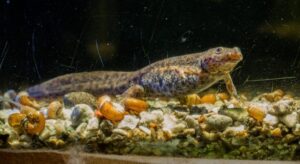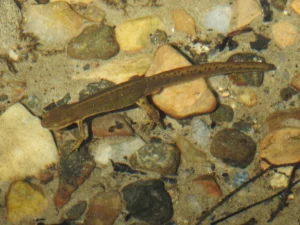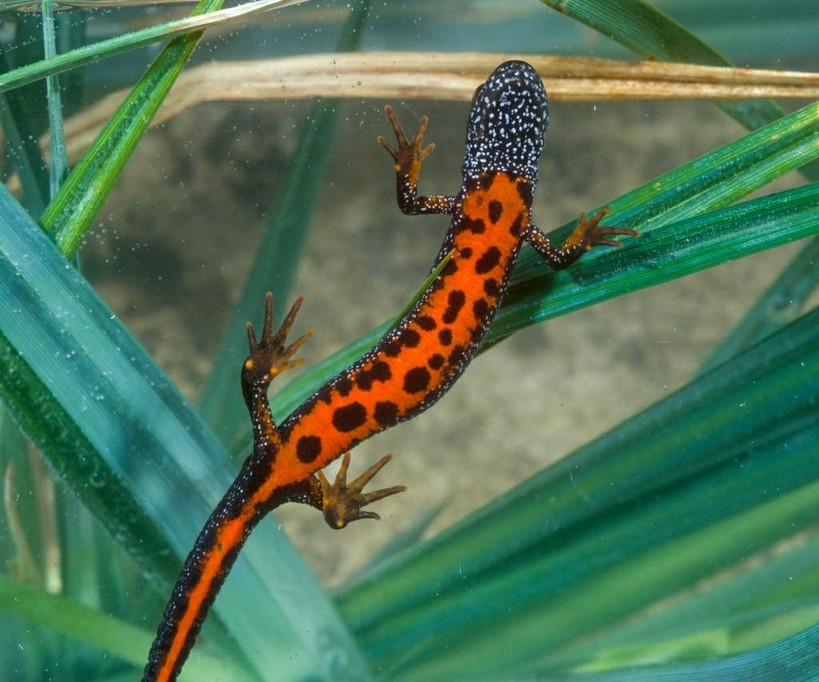You walk into a pet shop and notice a tank with tiny, smooth-skinned creatures gliding through the water. Their tails sway gently, their toes spread wide like little paddles, and their eyes look calm and steady.
At first, you might think they’re small fish or tiny lizards. But then you realize, they’re newts.
That makes you wonder: are newts actually kept as pets?
Yes, newts are often kept as pets, especially species like the Eastern newt, fire belly newt, and Spanish ribbed newt. They’re interesting to watch and don’t need as much space as some reptiles, but they need very specific care to stay healthy.
Owning a newt can be fun, but it’s not just putting one in a tank and feeding it flakes.
These amphibians have special needs, and without proper care, they can get sick or die quickly.
Why People Keep Newts as Pets
Newts attract people for a few reasons:
-
They look unusual. Smooth skin, swaying tails, and bright colors (especially fire belly newts with red bellies) make them eye-catching.
-
They’re quiet. Unlike parrots, dogs, or even frogs, newts don’t make noise.
-
They don’t need huge tanks. Compared to turtles or fish, newts can live in smaller enclosures.
-
They’re interesting to watch. Their slow movements, swimming, and feeding can feel almost meditative.

For someone who loves nature but doesn’t have room for a big reptile or aquarium, a newt might seem like the perfect choice.
Popular Pet Newt Species
Not every newt is common as a pet, but a few are widely kept:
-
Eastern Newt (Notophthalmus viridescens) – Found in North America, hardy and interesting with its red eft stage.
-
Fire Belly Newt (Cynops pyrrhogaster or Cynops orientalis) – Popular for bright orange bellies and active swimming.
-
Spanish Ribbed Newt (Pleurodeles waltl) – Larger than most, known for pushing ribs through its skin as a defense.
-
Paddle-Tailed Newt (Paramesotriton species) – Attractive patterns, less common.

Each species has its quirks. Some live mostly in water, others need both land and water. That’s why doing research before getting one is very important.
What Kind of Habitat Do Pet Newts Need?
Keeping a newt means creating a little piece of nature at home. They don’t survive well in simple glass bowls or dry cages.
A proper habitat usually includes:
-
Aquarium or terrarium: 10–20 gallon tank for a few newts.
-
Water and land areas: Many species need both. Some spend more time in water, others crawl onto land.
-
Clean water: Filtered and dechlorinated. Tap water without treatment can kill them.
-
Plants and hiding spots: Live or fake plants, rocks, and caves give them security.
For example, fire belly newts like setups where they can swim through plants and hide under logs. If they feel exposed, they get stressed.
What Do Pet Newts Eat?
Newts are carnivores. They don’t nibble lettuce or eat flakes like goldfish.
Instead, they like:
-
Bloodworms
-
Earthworms
-
Small insects
-
Brine shrimp
-
Special amphibian pellets

Watching a newt eat is fascinating. They snap their heads forward quickly, grab the food, and swallow it whole.
It looks slow compared to a fish darting around, but it works perfectly.
What Are the Challenges of Keeping Newts?
While newts seem easy, they do have challenges:
-
Temperature: Most prefer cooler water. A warm room without cooling can stress them.
-
Handling: They don’t like being held. Their skin is delicate, and oils from your hands can harm them.
-
Escape artists: They climb out of tanks if lids aren’t secure. A missing newt can dry out and die within hours.
-
Feeding: Live or frozen foods can be harder to provide than dry pellets.
-
Health issues: Poor water quality causes skin infections and stress.
Basically, newts aren’t starter pets for kids. They’re better for someone patient and willing to keep a careful setup.
Are Wild-Caught Newts Kept as Pets?
Yes, but it gets tricky. Many newts sold in pet shops, especially fire belly newts, were collected from the wild.
This causes two problems:
-
Wild populations decline: Collecting thousands messes up ecosystems.
-
Health risks: Wild-caught newts often carry parasites or diseases.
Captive-bred newts are much better, but harder to find. Still, the demand for cheap pets keeps wild capture happening.
Are Newts Legal to Keep as Pets?
Most places allow it, but with rules. For example:
-
Some U.S. states require permits to collect or sell native species like Eastern newts.
-
Import laws limit certain newts to stop the spread of chytrid fungus, a deadly amphibian disease.
Local rules vary, so check your laws before getting a pet newt.
Do Newts Make Good Pets?
It depends on what you want.
-
If you want a cuddly, interactive pet, no, newts aren’t for that.
-
If you want something low-energy to watch rather than handle, yes, they’re great.
-
If you love keeping natural setups with plants, water, and quiet creatures, they can be very rewarding.
They’re more like keeping an aquarium than having a dog or cat.
Risks of Releasing Pet Newts into the Wild
Never release pet newts into the wild. Even if they’re native, they can carry diseases or genes that harm local populations.

In Florida, California, and parts of Europe, released pet newts have caused problems.
If you can’t care for a pet newt, it’s best to rehome it or contact a rescue group.
Watching Pet Newts Can Be Interesting
Owning a newt isn’t about tricks or cuddles. It’s about slowing down and paying attention. You can watch them:
-
Float quietly in water with just their nose above the surface.
-
Crawl across a mossy rock with surprising grace.
-
Snap up food with quick, sudden lunges.
There’s a calm beauty in their movements that makes you appreciate the small details of nature.
Conclusion
Yes, newts are kept as pets all around the world. Popular species include the Eastern newt, fire belly newt, and Spanish ribbed newt. They’re interesting, quiet, and unique, but not easy pets. They need clean water, cooler temperatures, and live or frozen food.
They’re best for people who enjoy creating natural habitats and watching rather than handling. For them, newts can be very rewarding.
The important thing is to treat them with respect, never take wild ones from nature, never release pets into the wild, and remember even a tiny amphibian depends on careful balance to survive.
So yes, newts are pets, but they’re more than that. They’re little windows into the wild, showing you ponds, forests, and streams right inside your home.
Hi, my name is Ezra Mushala, i have been interested animals all my life. I am the main author and editor here at snakeinformer.com.

